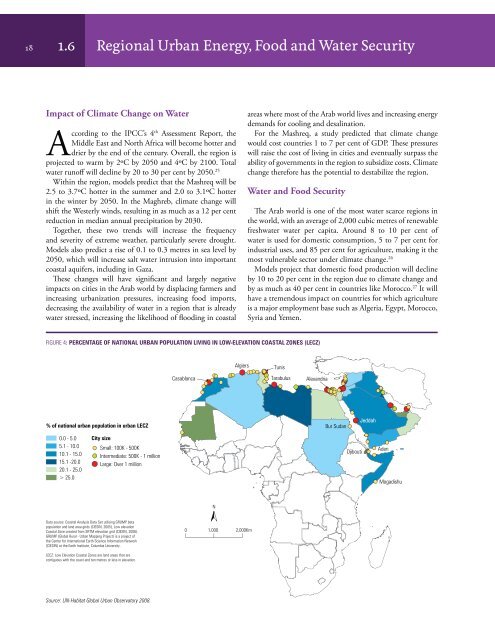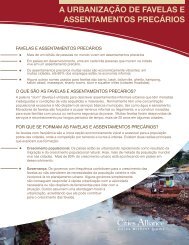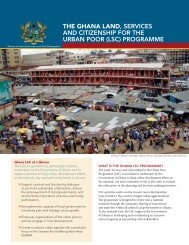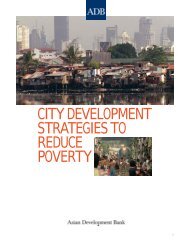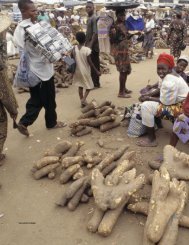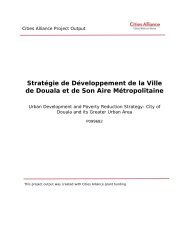Arab Cities2012 - Cities Alliance
Arab Cities2012 - Cities Alliance
Arab Cities2012 - Cities Alliance
Create successful ePaper yourself
Turn your PDF publications into a flip-book with our unique Google optimized e-Paper software.
18<br />
1.6<br />
Regional Urban Energy, Food and Water Security<br />
Impact of Climate Change on Water<br />
According to the IPCC’s 4 th Assessment Report, the<br />
Middle East and North Africa will become hotter and<br />
drier by the end of the century. Overall, the region is<br />
projected to warm by 2ºC by 2050 and 4ºC by 2100. Total<br />
water runoff will decline by 20 to 30 per cent by 2050. 25<br />
Within the region, models predict that the Mashreq will be<br />
2.5 to 3.7ºC hotter in the summer and 2.0 to 3.1ºC hotter<br />
in the winter by 2050. In the Maghreb, climate change will<br />
shift the Westerly winds, resulting in as much as a 12 per cent<br />
reduction in median annual precipitation by 2030.<br />
Together, these two trends will increase the frequency<br />
and severity of extreme weather, particularly severe drought.<br />
Models also predict a rise of 0.1 to 0.3 metres in sea level by<br />
2050, which will increase salt water intrusion into important<br />
coastal aquifers, including in Gaza.<br />
These changes will have significant and largely negative<br />
impacts on cities in the <strong>Arab</strong> world by displacing farmers and<br />
increasing urbanization pressures, increasing food imports,<br />
decreasing the availability of water in a region that is already<br />
water stressed, increasing the likelihood of flooding in coastal<br />
areas where most of the <strong>Arab</strong> world lives and increasing energy<br />
demands for cooling and desalination.<br />
For the Mashreq, a study predicted that climate change<br />
would cost countries 1 to 7 per cent of GDP. These pressures<br />
will raise the cost of living in cities and eventually surpass the<br />
ability of governments in the region to subsidize costs. Climate<br />
change therefore has the potential to destabilize the region.<br />
Water and Food Security<br />
FIGURE 4: PERCENTAGE OF NATIONAL URBAN POPULATION LIVING IN LOW-ELEVATION COASTAL ZONES (LECZ)<br />
% of national urban population in urban LECZ<br />
0.0 - 5.0<br />
5.1 - 10.0<br />
10.1 - 15.0<br />
15.1 -20.0<br />
20.1 - 25.0<br />
> 25.0<br />
City size<br />
Small: 100K - 500K<br />
Intermediate: 500K - 1 million<br />
Large: Over 1 million<br />
Source: UN-Habitat Global Urban Observatory 2008.<br />
Casablanca<br />
N<br />
Algiers<br />
0 1,000 2,000Km<br />
The <strong>Arab</strong> world is one of the most water scarce regions in<br />
the world, with an average of 2,000 cubic metres of renewable<br />
freshwater water per capita. Around 8 to 10 per cent of<br />
water is used for domestic consumption, 5 to 7 per cent for<br />
industrial uses, and 85 per cent for agriculture, making it the<br />
most vulnerable sector under climate change. 26<br />
Models project that domestic food production will decline<br />
by 10 to 20 per cent in the region due to climate change and<br />
by as much as 40 per cent in countries like Morocco. 27 It will<br />
have a tremendous impact on countries for which agriculture<br />
is a major employment base such as Algeria, Egypt, Morocco,<br />
Syria and Yemen.<br />
Tunis<br />
Tarabulus<br />
Alexandria<br />
Bur Sudan<br />
Djibouti<br />
Jeddah<br />
Aden<br />
Mogadishu


